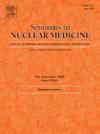Theranostics in Lung Neuroendocrine Tumors
IF 5.9
2区 医学
Q1 RADIOLOGY, NUCLEAR MEDICINE & MEDICAL IMAGING
引用次数: 0
Abstract
In the last 2 decades, there has been a noticeable increase in the incidence of neuroendocrine tumors, in part due to improved understanding of pathology and/or availability of more sensitive and accurate diagnostic tests. While gastrointestinal tract and pancreas are the most common sites of origin, lung neuroendocrine tumors (LNETs) are also frequently reported and need special considerations from diagnostic as well as therapeutic aspects.
Radiopharmaceutical therapy (Theranostics) is a novel approach which utilizes a pair of diagnostic and therapeutic agents that share a common target on tumor sites. Precise treatment of the disease with minimum side effects is the principal aim of Theranostics.
It's a known fact that somatostatin receptors (SSTR) are abundantly expressed in neuroendocrine tumors. With the advent of highly specific radiopharmaceuticals targeting SSTR receptors for both diagnosis as well as treatment and other targeted therapies, management of LNETs has become less challenging. Still, there exists significant ambiguity in relation to management of LNETs with a scope of novel diagnostic and therapeutic strategies to pitch in.
This review focuses on the role of established evidence for Theranostics strategies in the management of LNETs and highlights the potential future role of newer targets which would be of promising value in addressing such rare and complex tumor biology.
肺神经内分泌肿瘤的治疗。
在过去的20年里,神经内分泌肿瘤的发病率显著增加,部分原因是对病理学的了解有所提高和/或有了更敏感、更准确的诊断测试。虽然胃肠道和胰腺是最常见的起源部位,但肺神经内分泌肿瘤(LNETs)也经常被报道,需要从诊断和治疗方面进行特殊考虑。放射药物治疗(Theranostics)是一种利用一对诊断和治疗药物在肿瘤部位共享一个共同目标的新方法。以最小的副作用精确治疗疾病是治疗学的主要目标。众所周知,生长抑素受体(SSTR)在神经内分泌肿瘤中大量表达。随着针对SSTR受体的高特异性放射性药物的出现,用于诊断和治疗以及其他靶向治疗,LNETs的管理变得不那么具有挑战性。尽管如此,在LNETs的管理方面仍存在显著的模糊性,需要投入新的诊断和治疗策略。这篇综述的重点是治疗学策略在LNETs管理中的作用,并强调了新靶点的潜在作用,这些靶点在解决这种罕见和复杂的肿瘤生物学方面具有很好的价值。
本文章由计算机程序翻译,如有差异,请以英文原文为准。
求助全文
约1分钟内获得全文
求助全文
来源期刊

Seminars in nuclear medicine
医学-核医学
CiteScore
9.80
自引率
6.10%
发文量
86
审稿时长
14 days
期刊介绍:
Seminars in Nuclear Medicine is the leading review journal in nuclear medicine. Each issue brings you expert reviews and commentary on a single topic as selected by the Editors. The journal contains extensive coverage of the field of nuclear medicine, including PET, SPECT, and other molecular imaging studies, and related imaging studies. Full-color illustrations are used throughout to highlight important findings. Seminars is included in PubMed/Medline, Thomson/ISI, and other major scientific indexes.
 求助内容:
求助内容: 应助结果提醒方式:
应助结果提醒方式:


